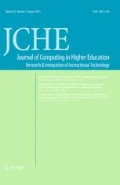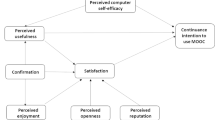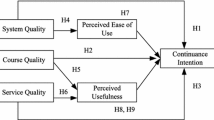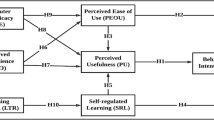Abstract
The aim of the present work is to contribute to the study of use intention for technologies related to the increasingly popular massive open online courses (MOOCs). Informed by a scientific literature review, the work proposes a behavioral model to explain use intention via various constructs. The results of the analysis verify the effect of user perceived satisfaction and autonomous motivation as the strongest predictors of use intention. The analysis also shows that perceived satisfaction is affected by the quality of the course, its entertainment value and its usefulness. The latter variable is also a major factor in explaining user emotions. The study provides an original focus in the study of perceived satisfaction and MOOC use intention by extending the models proposed in previous published literature in this emerging field.


Similar content being viewed by others
References
Adamopoulos, P. (2013). What makes a great MOOC? An interdisciplinary analysis of student retention in online courses. In 34th International conference on information systems: ICIS 2013 Association for Information Systems.
Aguaded, I., & Medina-Salguero, R. (2015). Criterios de calidad para la valoración y gestión de MOOC. RIED: Revista Iberoamericana de Educación a Distancia, 18(2), 119–143. https://doi.org/10.5944/ried.18.2.13579.
Ajzen, I. (1991). The theory of planned behavior. Organizational Behavior and Human Decision Processes, 50(2), 179–211.
Alexandron, G., Yoo, L. Y., Ruipérez-Valiente, J. A., Lee, S., & Pritchard, D. E. (2019). Are MOOC learning analytics results trustworthy? With fake learners, they might not be! International Journal of Artificial Intelligence in Education, 29, 484–506.
Alraimi, K. M., Zo, H., & Ciganek, A. P. (2015). Understanding the MOOCs continuance: The role of openness and reputation. Computers and Education, 80, 28–38. https://doi.org/10.1016/j.compedu.2014.08.006.
Ayala, C., Dick, G., & Treadway, J. (2014). The MOOCs are coming! Revolution or fad in the Business School? Communications of the Association for Information Systems: Vol. 35, Article 12. Available at http://aisel.aisnet.org/cais/vol35/iss1/12.
Beaudry, A., & Pinsonneault, A. (2010). The other side of acceptance: Studying the direct and indirect effects of emotions on information technology use. MIS Quarterly, 34(4), 689–710. https://doi.org/10.2307/25750701.
Brahimi, T., & Sarirete, A. (2015). Learning outside the classroom through MOOCs. Computers in Human Behavior, 51, 604–609. https://doi.org/10.1016/j.chb.2015.03.013.
Camilleri, A. F., Ehlers, U. D., Palowski, J. (2014). State of the art review of quality issues related to open educational resources (OER). JRC IPTS report. Luxembourg: Publication Offices of the European Union. http://doi.org/10.2791/80171.
Castañeda, J. A., Muñoz-Leiva, F., & Luque, T. (2007). Web acceptance model (WAM): Moderating effects of user experience. Information and Management, 44(4), 384–396. https://doi.org/10.1016/j.im.2007.02.003.
Castaño, C., Maiz, I., & Garay, U. (2015). Percepción de los participantes sobre el aprendizaje en un MOOC. RIED. Revista Iberoamericana De Educación a Distancia, 18(2), 197–221. https://doi.org/10.5944/ried.18.2.13444.
Chang, J. J., Lin, W. S., & Chen, H. R. (2019). How attention level and cognitive style affect learning in a MOOC environment? Based on the perspective of brainwave analysis. Computers in Human Behavior, 100, 209–217.
Cigdem, H., & Ozturk, M. (2016). Factors affecting students’ behavioral intention to use LMS at a Turkish post-secondary vocational school. International Review of Research in Open and Distance Learning. https://doi.org/10.19173/irrodl.v17i3.2253.
Conole, G. (2016). MOOCs as disruptive technologies: strategies for enhancing the learner experience and quality of MOOCs. RED. Revista de Educación a Distancia. https://doi.org/10.6018/red/50/2.
Daniel, J., Vázquez, E., & y Gisbert, M. (2015). El futuro de los MOOC: ¿aprendizaje adaptativo o modelo de negocio? RUSC. Universities and Knowledge Society Journal, 12(1), 64–74. https://doi.org/10.7238/rusc.v12i1.2475.
Del Barrio, S., Arquero, J. L., & Romero-Frías, E. (2015). Personal learning environments acceptance model: The role of need for cognition, e-learning satisfaction and students’ perceptions. Journal of Educational Technology and Society, 18(3), 129–141.
Del Barrio, S. & Luque, T (2012). Análisis de Ecuaciones Estructurales, en Luque, T. (coord.), Técnicas de análisis de datos en investigación de mercados. Madrid, España: Ediciones Pirámide.
Fornell, C., & Larcker, D. F. (1981). Evaluating structural equation models with unobservable variables and measurement error. Journal of Marketing Research. https://doi.org/10.2307/3151312.
Fortin, D. R., & Dholakia, R. R. (2005). Interactivity and vividness effects on social presence and involvement with a web-based advertisement. Journal of Business Research, 58, 387–396. https://doi.org/10.1016/S0148-2963(03)00106-1.
García-Martínez, C., Cerezo, R., Bermúdez, M., & Romero, C. (2019). Improving essay peer grading accuracy in massive open online courses using personalized weights from student’s engagement and performance. Journal of Computer Assisted Learning. https://doi.org/10.1111/jcal.12316.
Gupta, K. P. (2019). Investigating the adoption of MOOCs in a developing country. Interactive Technology and Smart Education. https://doi.org/10.1108/itse-06-2019-0033.
Hair, J. F., Black, W. C., Babin, B. J., & Anderson, R. E. (2010). Multivariate data analysis. London: Pearson.
Hibbeln, M. T., Jenkins, J. L., Schneider, C., Valacich, J., & Weinmann, M. (2016). Inferring negative emotion from mouse cursor movements. MIS Quarterly, 41(1), 1–21.
Hone, K. S., & El Said, G. R. (2016). Exploring the factors affecting MOOC retention: A survey study. Computers and Education, 98, 157–168. https://doi.org/10.1016/j.compedu.2016.03.016.
Hood, N., & Littlejohn, A. (2016). MOOC Quality: The need for new measures. Journal of Learning for Development-JL 4D, 3(3). Retrieved from http://www.jl4d.org/index.php/ejl4d/article/view/165.
Hu, X., Wu, G., Wu, Y., & Zhang, H. (2010). The effects of Web assurance seals on consumers’ initial trust in an online vendor: A functional perspective. Decision Support Systems, 48(2), 407–418.
Huang, L., Zhang, J., & Liu, Y. (2017). Antecedents of student MOOC revisit intention: Moderation effect of course difficulty. International Journal of Information Management, 37(2), 84–91. https://doi.org/10.1016/j.ijinfomgt.2016.12.002.
Huanhuan, W., & Xu, L. (2015). Research on technology adoption and promotion strategy of MOOC. The Institute of Electrical and Electronics Engineers, Inc. (IEEE) Conference proceedings (pp. 907–910). http://doi.org/10.1109/ICSESS.2015.7339201.
Hyo-Jeong So, Y. J. J., & Kim, H. E. (2018). Examination of relationships among students’ self-determination, technology acceptance, satisfaction, and continuance intention to use K-MOOCs. Computer and Education. https://doi.org/10.1016/j.compedu.2018.01.003.
Inamorato dos Santos, A., Punie, y., Castaño-Muñoz, J. (2016). Opening up education: A support framework for higher education institutions. JRC Science for Policy Report, EUR 27938 EN. https://doi.org/10.2791/293408.
Kay, R. H., & Loverock, S. (2008). Assessing emotions related to learning new software: The computer emotion scale. Computers in Human Behavior, 24(4), 1605–1623. https://doi.org/10.1016/j.chb.2007.06.002.
Kizilcec, R. F., Piech, C., & Schneider, E. (2013). Deconstructing disengagement: analyzing learner subpopulations in massive open online courses. In Proceedings of the third international conference on learning analytics and knowledge (pp. 170–179). New York, NY: ACM. https://doi.org/10.1145/2460296.2460330.
Lee, M. C. (2010). Explaining and predicting users’ continuance intention toward e-learning: An extension of the expectation–confirmation model. Computers and Education, 54(2), 506–516. https://doi.org/10.1016/j.compedu.2009.09.002.
Lee, B. C., Yoon, J. O., & Lee, I. (2009). Learners’ acceptance of e-learning in South Korea: Theories and results. Computers and Education, 53(4), 1320–1329. https://doi.org/10.1016/j.compedu.2009.06.014.
Li, K. (2019). MOOC learners’ demographics, self-regulated learning strategy, perceived learning and satisfaction: A structural equation modeling approach. Computers and Education, 132, 16–30.
Liébana-Cabanillas, F., Muñoz-Leiva, F., & Sánchez-Fernández, J. (2018). A global approach to the analysis of user behavior in mobile payment systems in the new electronic environment. Service Business, 12(1), 25–64.
Lin, T. C., & Huang, C. C. (2008). Understanding knowledge management system usage antecedents: An integration of social cognitive theory and task technology fit. Information and Management, 45(6), 410–417. https://doi.org/10.1016/j.im.2008.06.004.
Liyanagunawardena, T. R., Adams, A. A., & Williams, S. A. (2013). MOOCs: A systematic study of the published literature 2008–2012. International Review of Research in Open and Distributed Learning, 14(3), 202–227. https://doi.org/10.19173/irrodl.v14i3.1455.
Ma, L., & Lee, C. S. (2019). Investigating the adoption of MOOC s: A technology user-environment perspective. Journal of Computer Assisted learning, 35(1), 89–98.
Magen-Nagar, N., & Cohen, L. (2017). Learning strategies as a mediator for motivation and a sense of achievement among students who study in MOOCs. Education and Information Technologies, 22(3), 1271–1290. https://doi.org/10.1007/s10639-016-9492-y.
Mikalef, P., Pappas, I. O., & Giannakos, M. (2016). An integrative adoption model of video-based learning. The International Journal of Information and Learning Technology, 33(4), 219–235. https://doi.org/10.1108/ijilt-01-2016-0007.
Mohammadi, H. (2015). Investigating users’ perspectives on e-learning: An integration of TAM and IS success model. Computers in Human Behavior, 45, 359–374. https://doi.org/10.1016/j.chb.2014.07.044.
Mohapatra, S., & Mohanty, R. (2016). Adopting MOOCs for afforable quality education. Education and Information Technologies. https://doi.org/10.1007/s10639-016-9526-5.
Mora, C. E. (2011). La calidad del servicio Y la satisfacción del consumidor. REMark, 10(2), 146. https://doi.org/10.5585/remark.v10i2.2212.
Pappas, I. O., Giannakos, M. N., & Mikalef, P. (2017). Investigating students’ use and adoption of with-video assignments: Lessons learnt for video-based open educational resources. Journal of Computing in Higher Education, 29(1), 160–177. https://doi.org/10.1007/s12528-017-9132-6.
Pérez-Sanagustín, M., Hilliger, I., Alario-Hoyos, C., Kloos, C. D., & Rayyan, S. (2017). H-MOOC framework: Reusing MOOCs for hybrid education. Journal of Computing in Higher Education, 29(1), 47–64.
Pursel, B. K., Zhang, L., Jablokow, K. W., Choi, G. W., & Velegol, D. (2016). Understanding MOOC students: Motivations and behaviours indicative of MOOC completion. Journal of Computer Assisted Learning, 32(3), 202–217.
Puska, A., Ejubovic, A., & Beganovic, A. I. (2016). Student feedback as a guideline for higher education quality enhancement. Ekonomika, 62(4), 39–53. https://doi.org/10.5937/ekonomika1604039P.
Qin, M., & Xu, S. (2007). An extended expectation confirmation model for information systems continuance. In 2007 International conference on wireless communications, networking and mobile computing (pp. 3874–3877). IEEE. https://doi.org/10.1109/wicom.2007.959.
Rabin, E., Kalman, Y. M., & Kalz, M. (2019). An empirical investigation of the antecedents of learner-centered outcome measures in MOOCs. International Journal of Educational Technology in Higher Education, 16(1), 14.
Ray, S., Ow, T., & Kim, S. S. (2011). Security assurance: How online service providers can influence security control perceptions and gain trust. Decision Sciences, 42(2), 391–412.
Reich, J., & Ruipérez-Valiente, J. A. (2019). The MOOC pivot. Science, 363(6423), 130–131.
Riehemann, J., Hellmann, J. H., & Jucks, R. (2018) “Your words matter!” Relevance of individual participation in xMOOCs. Active Learning in Higher Education. https://doi.org/10.1177/1469787418779154.
Rienties, B., & Rivers, B. A. (2014). Measuring and understanding learner emotions: Evidence and prospects. Learning Analytics Review, 1, 1–28.
Roca, J. C., & Gagné, M. (2008). Understanding e-learning continuance intention in the workplace: A self-determination theory perspective. Computers in Human Behavior, 24(4), 1585–1604. https://doi.org/10.1016/j.chb.2007.06.001.
Román, A. P., González, A. B., & Idoeta, C. M. (2014). Análisis del proceso de generación de lealtad en el entorno on-line a través de la calidad del servicio y de la calidad de la relación. Revista Europea de Dirección y Economía de la Empresa, 23(4), 175–183. https://doi.org/10.1016/j.redee.2014.09.003.
Ruiz, M., Palací, F. J., Salcedo, A., & Garcés, J. (2010). E-satisfacción: Una aproximación cualitativa. Acción psicológica. http://doi.org/10.5944/ap.7.1.209.
Shahijan, M. K., Rezaei, S., & Amin, M. (2016). International students’ course satisfaction and continuance behavioral intention in higher education setting: An empirical assessment in Malaysia. Asia Pacific Education Review, 17(1), 41–62. https://doi.org/10.1007/s12564-015-9410-9.
Shanghai Ranking (2017). Global Ranking of Academic Subjects. Retrieved from https://drive.google.com/file/d/0Bw2rAawlHlvBYndVM2x5cHREdWs/view.
Sivo, S. A., Fan, X., Witta, E. L., & Willse, J. T. (2006). The search for “optimal” cutoff properties: Fit index criteria in structural equation modeling. The Journal of Experimental Education, 74(3), 267–288.
Song, Z. X., Cheung, M. F., & Prud’Homme, S. (2017). Theoretical frameworks and research methods in the study of MOOC/e-learning behaviors: A theoretical and empirical review. In New ecology for education—Communication X learning (pp. 47–65). Springer, Singapore. https://doi.org/10.1007/978-981-10-4346-8_5.
Sun, P. C., Tsai, T. J., Finger, G., Chen, Y. Y., & Yeh, D. (2008). What drives a successful e-Learning? An empirical investigation of the critical factors influencing learner satisfaction. Computers and Education, 50(4), 1183–1202. https://doi.org/10.1016/j.compedu.2006.11.007.
Tang, H., Xing, W., & Pei, B. (2018). Exploring the temporal dimension of forum participation in MOOCs. Distance Education, 39(3), 353–372.
Teo, T., Sang, G., Mei, B., & Hoi, C. K. W. (2019). Investigating pre-service teachers’ acceptance of Web 2.0 technologies in their future teaching: A Chinese perspective. Interactive Learning Environments, 27(4), 530–546.
Thong, J. Y. L., Hong, S. J., & Tam, K. Y. (2006). The effects of post-adoption beliefs on the expectation–confirmation model for information technology continuance. International Journal of Human-Computer Studies, 64(9), 799–810. https://doi.org/10.1016/j.ijhcs.2006.05.001.
Udo, G. J., Bagchi, K. K., & Kirs, P. J. (2011). Using SERVQUAL to assess the quality of e-learning experience. Computers in Human Behavior, 27(3), 1272–1283. https://doi.org/10.1016/j.chb.2011.01.009.
Venkatesh, V., & Davis, F. D. (2000). A theoretical extension of the technology acceptance model: Four longitudinal field studies. Management Science, 46(2), 186–204. https://doi.org/10.1287/mnsc.46.2.186.11926.
Wells, W. D. (1997). Measuring advertising effectiveness. London: Routledge.
Wojciechowski, R., & Cellary, W. (2013). Evaluation of learners’ attitude toward learning in ARIES augmented reality environments. Computers and Education, 68, 570–585. https://doi.org/10.1016/j.compedu.2013.02.014.
Xing, W. (2018). Exploring the influences of MOOC design features on student performance and persistence. Distance Education. https://doi.org/10.1080/01587919.2018.1553560.
Xiong, Y., Li, H., Kornhaber, M. L., Suen, H. K., Pursel, B., & Goins, D. D. (2015). Examining the relations among student motivation, engagement, and retention in a MOOC: A structural equation modeling approach. Global Education Review, 2(3), 23–33.
Xu, F. (2015). Research of the MOOC study behavior influencing factors. In Proceedings of international conference on advanced information and communication technology for education (pp. 18–22). Amsterdam: Atlantis Press. https://doi.org/10.2991/icaicte-15.2015.5.
Yuan, L., & Powell, S. (2013). MOOCs and open education: Implications for higher education. White Paper. Retrieved from http://publications.cetis.org.uk/wp-content/uploads/2013/03/MOOCs-and-Open-Education.pdf.
Zambrano, J. (2016). Factores predictores de la satisfacción de estudiantes de cursos virtuales. RIED. Revista Iberoamericana de Educación a Distancia, 19(2), 217–235. http://doi.org/10.5944/ried.19.2.15112.
Zhang, J. (2016). Can MOOCs be interesting to students? An experimental investigation from regulatory focus perspective. Computers and Education, 95, 340–351. https://doi.org/10.1016/j.compedu.2016.02.003.
Zhou, M. (2016). Chinese university students’ acceptance of MOOCs: A self-determination perspective. Computers and Education, 92, 194–203. https://doi.org/10.1016/j.compedu.2015.10.012.
Author information
Authors and Affiliations
Corresponding author
Ethics declarations
Conflict of interest
All authors declare that they have no conflict of interest.
Additional information
Publisher's Note
Springer Nature remains neutral with regard to jurisdictional claims in published maps and institutional affiliations.
Appendix: Scales and items used in the study
Appendix: Scales and items used in the study
Construct | Questionnaire items adapted to the present study | References |
|---|---|---|
Perceived ease of use (PEU) | 1. I find it easy to be good at using MOOCs 2. I find it easy to learn how to work with MOOC systems 3. I find it easy to get the MOOC system to do what 4. I want it to 5. I find it easy to use MOOCs | Sun et al. (2008) |
Perceived usefulness (PU) | 1. Using MOOCs would improve my learning performance 2. Using MOOCs would increase my learning efficiency 3. Using MOOCs would be useful for me | Alraimi et al. (2015) |
Emotions (EM) | 1. Using MOOCs would be pleasant 2. Using MOOCs would be exciting 3. Using MOOCs would make me feel good | Pappas et al. (2017) |
Vividness of content (VC) | 1. The educational process of MOOCs seems lively 2. The educational process of MOOCs seems energetic 3. The educational process of MOOCs seems to be enlivening for the senses 4. I could take in the learning process of MOOCs via different sensory channels | Huang et al. (2017) |
Perceived interactivity (PI) | 1. The interactivity between teacher and student on a MOOC would enable me to better understand the content 2. The interactivity between teacher and student on a MOOC would enable me to learn more from the course 3. The interactivity between teacher and student on a MOOC would enable me to use summaries and compare them with others 4. The interactivity between teacher and student on a MOOC would enable me to resolve my questions | Huang et al. (2017) |
Controlled motivation (CM) | 1. I would use a MOOC if other people told me I should do so 2. I would feel under pressure from my friends/family/partner to use MOOCs 3. I would use a MOOC if my friends/family/partner were to tell me I should do so 4. I would feel embarrassed if I were not to use MOOCs in order to learn | Zhou (2016) |
Autonomous motivation (AM) | 1. I think using MOOCs is important for learning 2. I value the benefits of using MOOCs 3. I think it’s important to make an effort to use MOOCs to learn 4. I would study via MOOCs because it is important to do so 5. I would enjoy myself studying via MOOCs | Zhou (2016) |
Perceived entertainment (PE) | 1. Using MOOCs seems pleasant 2. I would enjoy myself using MOOCs 3. I would find it fun to use MOOCs | Alraimi et al. (2015) |
Perceived course quality (PCQ) | 4. The fact that MOOCs are conducted via the Internet means they are of better quality than other (offline) courses 5. The quality of MOOCs may compare favorably with that of other courses I have undertaken 6. I do not think the quality of a MOOC is influenced by the fact that it is undertaken via the Internet | Sun et al. (2008) |
Perceived satisfaction (PS) | 1. I would be satisfied with my decision to undertake a MOOC 2. If I had the chance to undertake a MOOC, I would be delighted to do so 3. I would be very satisfied with a MOOC 4. I feel that MOOCs are well-suited to my needs 5. I will undertake as many MOOCs as I can 6. I find the way MOOCs work disappointing 7. Undertaking a MOOC would be more difficult than other courses I have taken | Sun et al. (2008) |
Use intention (UI) | 1. I intend to use MOOCs in the future 2. My overall intention to use MOOCs in the future is very high 3. I would use MOOCs regularly in the future 4. I would think about using MOOCs | Pappas et al. (2017) |
Rights and permissions
About this article
Cite this article
Pozón-López, I., Higueras-Castillo, E., Muñoz-Leiva, F. et al. Perceived user satisfaction and intention to use massive open online courses (MOOCs). J Comput High Educ 33, 85–120 (2021). https://doi.org/10.1007/s12528-020-09257-9
Published:
Issue Date:
DOI: https://doi.org/10.1007/s12528-020-09257-9




